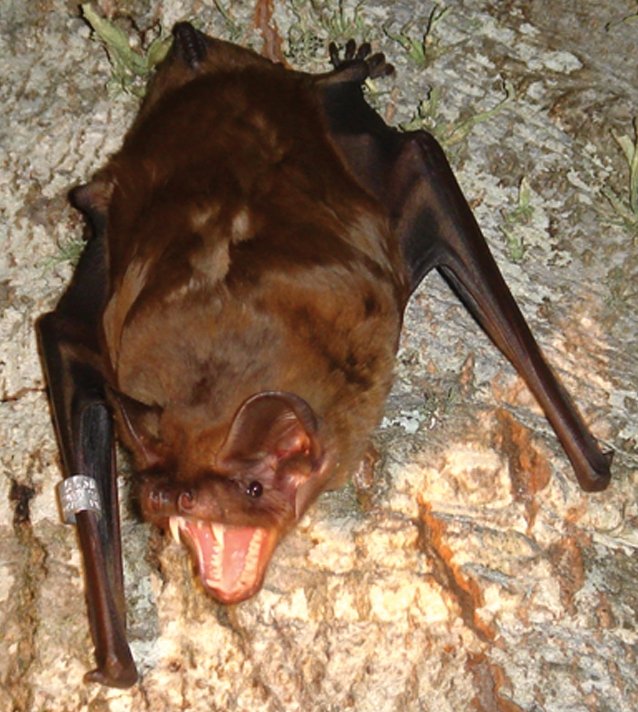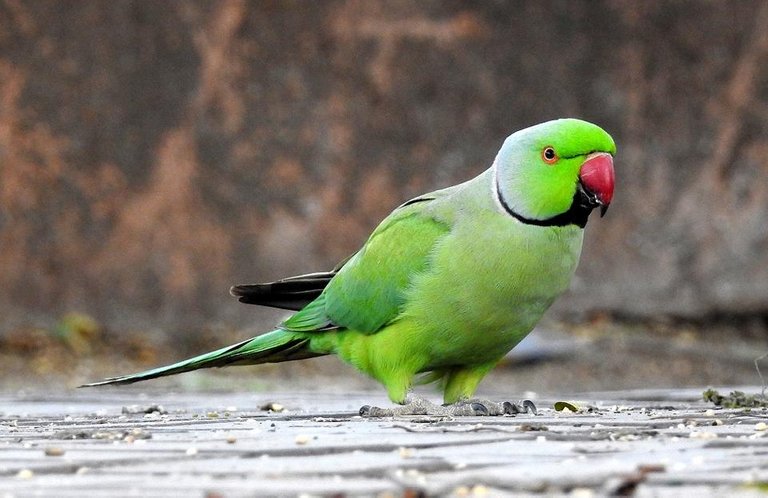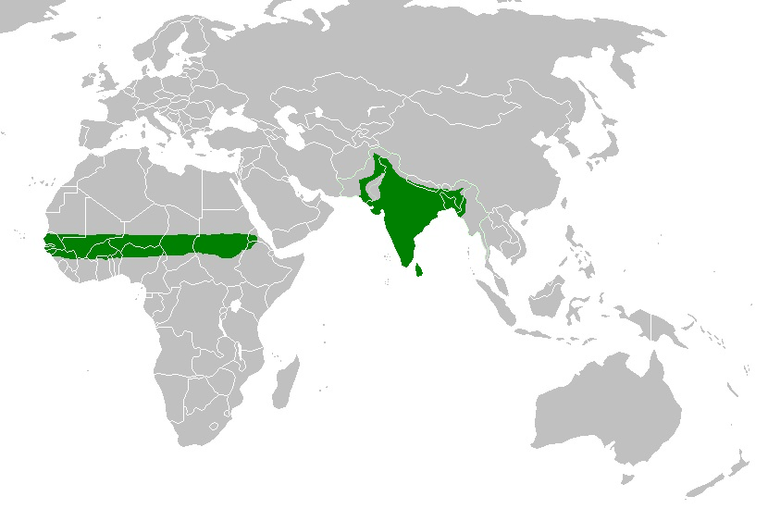The greater noctule bat (Nyctalus lasiopterus) is the largest species of bat we have in Europe, with a wingspan that can be as long as 46cm. They are pretty rare, and have been classified as Vulnerable by the IUCN Red List. This basically means that they are not in any immediate threat of extinction, but they are definitely heading towards this point unless we take measures to protect them.

A greater noctule bat. Image by Nicolharper at English Wikipedia, posted with the Creative Commons Attribution 2.5 Generic license.
In its natural setting, the greater noctule bats hunt and eat birds, and they are in fact the only bat that is capable of hunting birds while they are in flight. All other bat species who kill birds do so when the birds roosts, so it’s a pretty unique species. It is of course not able to kill and eat bigger birds, and in fact it seems like the exact opposite has happened at María Luisa Park in Seville, Spain.
How the greater noctules ended up being hunted by parakeets
The greater noctule bats have been living in hollow trees in María Luisa Park for a long time. They have been doing fine there despite the species declining in total, and they have had a good supply of both food and shelter. It might sound strange to have a population of bats in the middle of a park, but it is in fact one of the biggest breeding populations in all of Europe, so it’s a very important population for the species as a whole.
A few years ago people in the area started to notice that some bats were found dead with torn wings, and they even found corpses of nursing pups who generally don’t leave their shelter. More bats were found injured with wings that were badly harmed, rendering them unable to fly or even crawl back to their nests.
This phenomena brought the curiosity of a group of scientists from Estación Biológica de Doñana in Seville, and they began to investigate who could be behind the attack. No one has previously seen this type of attack on a greater noctule before, so it was a big mystery. After some investigation, the team quickly learned that is was rose-ringed parakeets (Psittacula krameri) who were behind the attacks, and even witnesses a few attacks.

A male rose-ringed parakeet. Image by Dr. Raju Kasambe, posted with the Creative Commons Attribution-Share Alike 4.0 International license.
But why are rose-ringed parakeets even in Spain?
Rose-ringed parakeets do have a huge range, and they are found in both Africa where they live close to the equator, and in some countries around India in Asia, including Pakistan, Myanmar and Bangladesh. But as you can see from the map below, they are not really found anywhere close to Spain at all.

The range of rose-ringed parakeets. Image is Public Domain.
The reason behind why they are found in María Luisa Park lies in the fact that they are very popular to keep as pets. They are a good species of parrot to keep if you are into that type of pet animals, but the fact that they are able to thrive in a huge range naturally also means that they are highly adaptable when it comes to surviving in new areas.
When a research team surveyed the amounts of feral rose-ringed parakeets in Europe, they found out that there was over 85,000 wild individuals in 10 different European countries, including countries such as Germany, Belgium and the UK. The same study concludes that the rose-ringed parakeet is the most invasive species of bird in all of Europe, and that is exactly what happened in María Luisa Park in Spain.
Apparently 10 birds were confiscated and released back in the 1990s, but at that time no one expected them to be a problem. However, they began to reproduce, and by now they are estimated to be a population with several thousand members.
As the numbers of parakeets grew, they needed more places to nest, and just like the greater noctules, they also really enjoy to make nests in the hollow trees in the park.

Baby birds who poke out of the tree. Image by Sarthak Shah, posted with the Creative Commons Attribution-Share Alike 3.0 Unported license.
As all the trees became occupied in the park, the parakeets needed to get rid of the trees the bats were using, and it turns out that they were fully capable of injuring and killing the bats, and steal their nests.
Can we save the greater noctule bats?
At this point it is believed to only be around 250 bats left in the park, so they are not in a good spot at all. The number of occupants per tree has also doubled compared to pre-invasion of parakeet levels.
The researchers behind the study believes that they only way they can save the population in the park is by eradicating the parakeets, and back in 2016 the city government decided to take action towards this. However, just before the plans were about to go into action, they backed out because of fear of what the public would think. Apparently more people prefer to have an invasive (but cute) parrot in the park instead of a rare species of bat that is threatened with extinction.
Some people have suggested putting out artificial “bat boxes” where the bats can create nests, but the greater noctules don’t really like these as much as other species of bats do. It seems like getting rid of, or severely reducing the rose-ringed parakeet population is the only solution, but unfortunately it seems impossible to do this when the public opposes it.
This mean that the greater noctule bats are heading for a rather uncertain future, and unless someone steps up and convinces the government to take action, more and more bats will be mutilated and killed by the aggressive parrots.
Thanks for reading
This is not the nicest story to read since it has a pretty bad ending, but thanks for reading it anyway. I hope you enjoyed learning more about the interactions between the greater noctules and the rose-ringed parakeets in this park in Spain, and don’t forget to leave a comment below if you got anything on your mind!
About @valth
Hey, I'm @valth - the author of this post. I love to write about nature, biology, animals, nature conservation, ecology and other related branches of science, and I occasionally write about my life, about Steem or about random stuff as well. I'm trying my best to write at least one post every day, so make sure to give me a follow if you enjoy my content and want to see more of it.
Join the @valth community!
I love nothing more than to engage with my readers, so please join the @valth community in the comment section. You will definitely find more information about the topic, personal experiences, questions, and even opposing views down there, so don't miss out on learning more.
I always reward users who post good comments, so please take the opportunity to share your views and get a small upvote in exchange for it.
Eg lærer alltid noko av artiklane dine. Tidleare trudde eg at skinnvengje (her synest eg det nynorske ordet er meir heldig enn flaggermus), var insektetande og fanga desse ved hjelp av sitt fenomenale ekkosystem. At dei kunne fanga og eta fuglar, var ukjent for meg. Men no veit eg det.
Mange takk.
At denne fuglefangande og fugleetande skinnvengja, er truga av ein papegøye var ôg interessant å lesa. Vonar at denne spesielle skinnvengja ikkje vert utrydda.
Artsrikdomen må me ta vare på.Mange takk for ein ny interessant og høgst leseverdig artikkel @Valth
Med vennleg helsing
@Siggjo
Myotis vivesi.Det er godt å høre at du lærte noe nytt av å lese posten min, @siggjo. De fleste flaggermusartene spiser enten insekter (eller holder seg til nektar), men man har jo også slike som disse som tar småfugler, og til og med noen som spiser fisk og skalldyr, som
Helt enig memd deg. I dette tilfellet er jo flaggermusen trua, mens papegøyen lever i beste velgående over store deler av verden, så hvis jeg skulle velge hadde det vært et enkelt valg.
For øvrig veldig artig å lære at flaggermus heter skinnvengje på nynorsk, og det var jo et mye finere ord en flaggermus!
Hilsen @valth
Shocked to read that Rose-ringed parakeets are responsible for the killings of Nyctalus lasiopterus. Parrot are consider to be most innocent bird in our region. People love them due to its speaking power(repeating words/ability) and their adoptability towards new surrondings.Mostly people who keep parrots they keep them is cage or confined space so I agree that pet parrots are not involved in damaged.
Amazing figure only 10 birds of 1990 made the total of 85,000 in Europe so a small mistake have a big consequences. Animal world is simple They follow the simple rule of "Survival for the fittest"
For the safety of bats María Luisa Park and its vicinity should be evacuated by parrots forcefully. Maybe parrots food with catcher cage may be helpful in this regard.
By the way parrot is very famous in our region. In our language we call parrot "Tota" During writing a comments there was a proverb coming in my mind so i decided why not share it with you.
"Tota Chasam ho jana"
In english it is used for a person who turns his eyes at the time of need, disloyal or parrot-eyed.
keep sharing @valth
Yeah, parrots are really cool pets. I actually grew up with a few parrots in cages, and they can be pretty cool to hang around when they talk.
And I agree with your strategy; caging and relocation them should not be that difficult, and I believe that they should prioritize saving the bats that are endangered.
Interesting saying about "Tota"! thanks for sharing :)
I used to have a pet a parakeet as a child...And he was so beautiful and I remember his bite was so powerful...Easily capable of injuring human skin...
I Never thought of the harms they could have done as an invasive specie...
And I remember that my parakeet loved eating Guava:)
What type of a parakeet did you have? A rose-ringed parakeet, or another type? :)
My family had a few parrots when I grew up, and you are definitely correct about them being able to injure human skin. The biggest they had was a Ara ararauna, which could probably snap off a finger if he wanted to.
Super interesting read! invasive species are really bad for the ecosystem of the area. Here in my area we have to deal with the Asian Carp which is destroying a lot of water areas.
Thanks, I'm glad you liked it!
Oh, I actually wrote a post about how the Asian Carp is ruining ecosystems in the US a while back, but that's probably about a year ago now. But they can be a huge problem to so many different species.
Hey @valth, Great article, as are the other articles you have written, that I have had a chance to read so far. Look forward to more in the future. Up voted and followed. :)
Thanks! I'm glad to hear that you liked it, and I'm very excited to have you as a follower :) I hope to see you around in the comment section in the future, @pellucidity!
Whee, invasive species are fun. :(
Very interesting information. I haven't even heard of these mice. The photos are amazing . Thank you for telling me. Pleased that you are interested in such problems. We are responsible for the animals that inhabit our planet. But parrots are fighting for a place under the sun too, @valth .
They are bats, not mice :) I'm glad you like the photos, but I did not take these myself; see the credit below each photo for more information.
Yes, that's true, but keep in mind that these parrots don't really belong in Spain at all, so they are considered invasive.
Not what I expected! We in the USA are trying to deal with white nose syndrome (Geomyces destructans).
Hehe. White nose syndrome is such a huge problem, and I'm just glad it has not found its way to Europe yet!
Big bat really
We must protect all animals
A very good article published well
Yes, we should try to protect all animals, but with this one we really have to choose between the parrots and the bats. Thanks for stopping by, @roselover.
You always come up with new information, i.never thought parrets could be killers :/ it is shocking news!
Well the solution of this thing could he that we should plant as many trees as we can!
Trees are a source of fresh air, so along with providing fresh air they could be houses of these bats and parrots!
Oh yeah, there are some parrots who can kill small mammals or other birds.
Planting trees is always a good solution! I'm just afraid that it will take too long for the trees to grow big enough to shelter the bats.
There should be an artificial method to plant trees too!
Planting them is not a problem, but it's very limited to how big trees you can plant. And the growing is what takes the longest. Getting a trees that is big enough to house bats or parrots would probably take 20+ years.
That's the law for animals. the strong oppress the weak.
Predators can become prey and that prey could be a predator.
Thanks for sharing us. I like your blog @valth.
Thanks, I'm glad you like my blog :)
You are welcome @valth
Thanks for your interesting information. Glad to read your nice story, I have never seen this type o bat before.
I'm glad you found the post interesting, @tangera! :)
ahan nice information but i think the noctule bats (Nyctalus lasiopterus) are a bit scary 😶
Hehe, luckily they are not dangerous for humans. They will only eat small birds, and they are not the type of bats that carry human diseases :)
thats really great <3 :)
a nice article ....its a call to save some species of animals in our ecosystem
Thank you. Yes, that's correct :)
oh my god, its looks scary
There's no need to be afraid of them, they won't attack humans.
That's a night flying birds, the birds food connect midnight..... thanks for sharing...
Sure. You're welcome :)
Does this include mammals that are protected by the state?This is a very large mvalia @valt, with wingspan up to 46 cm,
Yes, it's very large.
Can you elaborate on the question a bit? I don't completely understand what you mean.
What is the name of the first animal?
I do not see such strange animals anymore.
It literally says so just under the picture :P And it's a great noctule bat.
Congratulations @valth! You have completed some achievement on Steemit and have been rewarded with new badge(s) :
Click on any badge to view your own Board of Honor on SteemitBoard.
To support your work, I also upvoted your post!
For more information about SteemitBoard, click here
If you no longer want to receive notifications, reply to this comment with the word
STOPMany exotic species are threatened with extinction, mostly caused by human hands. We must try to keep them free..
good job @valth
Yes, I agree :)
Your Post Has Been Featured on @Resteemable!
Feature any Steemit post using resteemit.com!
How It Works:
1. Take Any Steemit URL
2. Erase
https://3. Type
reGet Featured Instantly & Featured Posts are voted every 2.4hrs
Join the Curation Team Here | Vote Resteemable for Witness
Congratulations! Your post has been selected as a daily Steemit truffle! It is listed on rank 18 of all contributions awarded today. You can find the TOP DAILY TRUFFLE PICKS HERE.
I upvoted your contribution because to my mind your post is at least 61 SBD worth and should receive 145 votes. It's now up to the lovely Steemit community to make this come true.
I am
TrufflePig, an Artificial Intelligence Bot that helps minnows and content curators using Machine Learning. If you are curious how I select content, you can find an explanation here!Have a nice day and sincerely yours,

TrufflePig